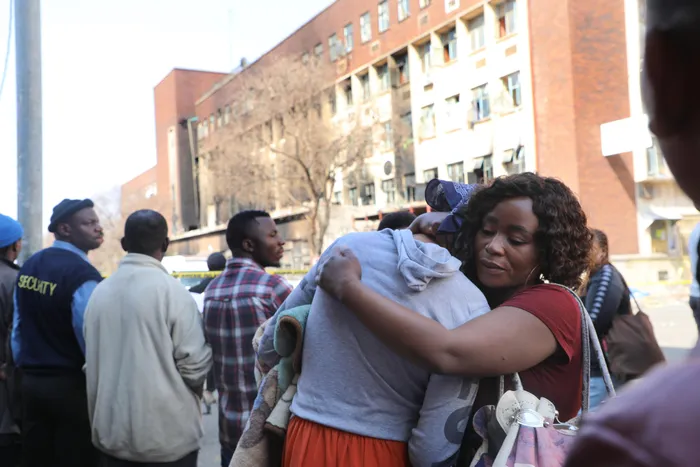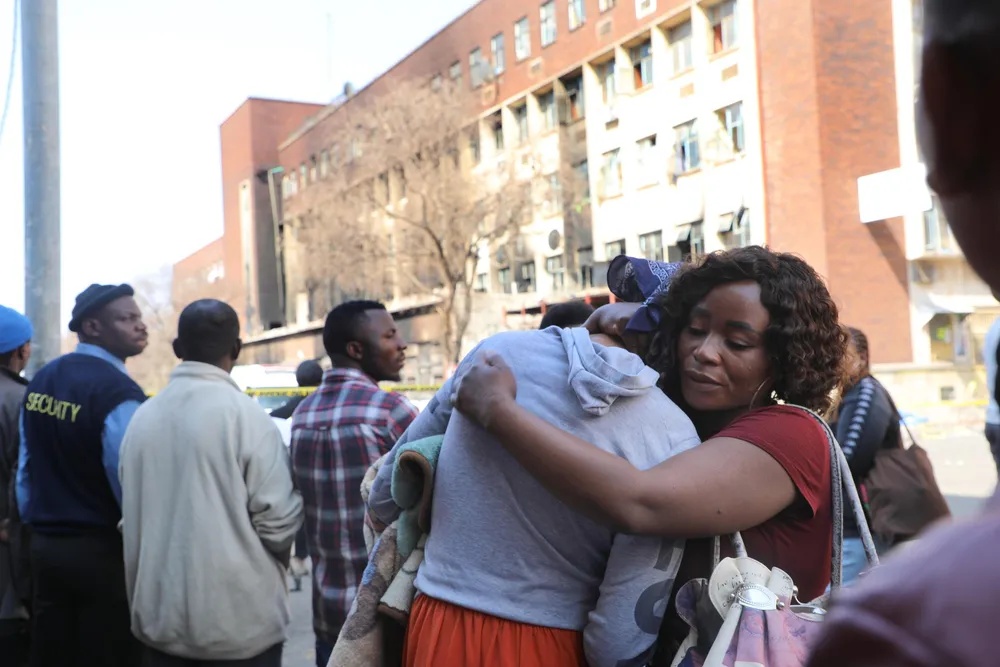The perils of hijacked buildings in SA

Picture: Timothy Bernard / African News Agency( ANA) - Following a fire that claimed the lives of more then 70 people the speaker of council Colleen Makhubele leads prayers at the four-story building where the tragedy took place.
Picture: Timothy Bernard/African News Agency (ANA) - Emergency service workers trying to douse the flames in the Albert street building in Marshalltown, Johannesburg.
By Michael Sutcliffe and Sue Bannister
Waking up to news of the tragedy on Thursday in which more than 70 people died, including 12 children, in a fire in a building in the Johannesburg CBD, we found a blame game at play. Some elements in the media were demanding that Premier Panyaza Lesufi and Executive Mayor Kabelo Gwamanda be immediately available for interviews while the emergency response teams were clearly still at work. Others blamed foreign migrants and NGOs for defending in court the right of people to stay in such buildings. Few commentators and critics seemed to be focusing on the tragedy of such loss of life.
Fortunately, later in the day the immediate responses of those grabbing such attention started calming down. President Cyril Ramaphosa’s, correct call was that it is a wake up call for all of us. That we need an all-of-society approach to address such issues is an important starting point. And the Premier’s Committee of Inquiry will hopefully provide us with a vehicle within which we can collectively unpack not only the immediate causes of this fire and the tragedy that resulted, but how we can address the very complex causes that have created such circumstances.
Fortuitously, on the day this tragedy happened, Public Works and Infrastructure Minister Sihle Zikalala opened an important meeting of built environment professionals and academics to work on strategies creating more resilient and sustainable built environments. Organised by one of his entities, the Council of the Built Environment, the deliberations show clearly that we not only have the complex challenges above ground (such as updating building regulations), but also challenges below ground such as ensuring our built environment is structurally safe and sound (for example, changing the codes and formulae used to decide how our stormwater system can deal with run off). We need a whole-of-society response to ensure that we work towards sustainability in meeting the challenges of climate variability, pandemics, emergencies and disasters.
The problem of hijacked and overcrowded buildings in Johannesburg is multifaceted and an intricate issue that involves various social, economic, legal, and political factors. Understanding the complexity of this issue requires an examination of several key aspects.

The first reality is that there is no quick fix solution, and it will take us decades to rid ourselves of the historical legacy of apartheid and forced removals, which has contributed to urban inequality, creating an environment where hijacked buildings can thrive. Many people who were previously disenfranchised were forcibly removed and have been left without proper housing and access to economic opportunities.
With the dawn of democracy, many left their homes to occupy abandoned or neglected buildings. In many cases, work seekers found shelters leading to a growth of over 35% in the number of 1-2 person households in Gauteng as a whole, with most of these people having no other option but to find shelter in informal settlements, backyard shacks and abandoned buildings. Of course, in these circumstances they have to pay for such accommodation, usually to those who “illegally” took over such land or built such unregulated shelters.
Our own experience in eThekwini came from confronting this reality when we found (then) more than 17 000 people living in 20 “abandoned” buildings. The people were mainly very productive women (with their children) who were making dresses for sale on the streets in Warwick Triangle. They were paying, on average, cash rentals which were double the most expensive commercial property in eThekwini, simply for the right to live in 9 square metres of an abandoned building, with no services. I called a number of the owners of these buildings to my office and they all indicated they had no idea of what was happening and they simply received monthly rents. I am glad to say many of them worked with the city to create sanitary and safe conditions including play spaces on the rooftops.
However these cases are generally slightly easier than dealing with hijacked buildings. In our large cities we are confronted with stark economic disparities. The lack of equitable access to basic services and economic opportunities drives some individuals to resort to hijacking buildings as a means of obtaining shelter, however precarious. These buildings often become hubs for criminal activities due to the lack of formal governance. Criminal elements can exploit these spaces for drug trafficking, prostitution, and other illicit activities, further exacerbating security concerns.

Ownership disputes and complex property rights make it difficult to address hijacked buildings effectively. Some properties might have unclear ownership due to historical land injustices, making it challenging to legally resolve the occupation. Evicting occupants from hijacked buildings is legally complex. Balancing the rights of informal occupants with property owners’ rights can lead to prolonged legal battles and uncertainty. In addition, the time it takes, and challenges experienced when trying to evict people from buildings, creates further problems. Even a task team we established with colleagues from the national security cluster could not fast-track solutions.
These delays are not only because of NGOs challenging eviction cases, but a recent example in eThekwini shows the difficulties municipalities have in dealing with such cases. The China Mall in the eThekwini CBD burnt down in January 2022, but even after court orders the property owner has still not demolished the building and so eThekwini has to now pay R28 million to demolish it and try and recover the funds.
Hijacked buildings lack access to proper infrastructure and basic services, such as sanitation, electricity, and water. This poses significant health and safety risks to the occupants and surrounding community. Illegal connections are often made, or people use gas, candles, paraffin stoves or even open fires in such buildings, including in informal housing, without any safety precautions being made. The partitions between each space in which each household lives are certainly not compliant with building and fire regulations. Exits are also blocked to ensure the “landlord” collects payments and to stop easy access by governmental officials.
The government’s response to hijacked buildings involves a delicate balance between addressing the housing needs of vulnerable populations and maintaining law and order. As a result government, usually national and local spheres, often work collectively to continue to deliver housing solutions which to date number over four million housing opportunities. Additional strategies are also often pursued including rehabilitation, formalisation, or eviction, each with its own challenges. Unfortunately, too, it is often not easy negotiating with such informal communities that form within hijacked buildings as they develop their own social structures and norms. These dynamics can both provide support for vulnerable individuals and perpetuate challenges such as crime and unsanitary conditions. In eThekwini we had to deal with a sensitive case of a building which had been hijacked by blind and disabled people who correctly argued that often their circumstances were not prioritised in housing delivery processes.
At the same time, it is not only challenges of existing communities, but also of those who profit from such buildings, from the “landlords” to other business interests who want to gentrify the building displacing occupants. The “landlords” who take over the buildings make it impossible for the actual public or private owners of such buildings to even enter them. We believe even in Johannesburg serious questions have been raised about previous initiatives to sell municipal buildings or land and undoubtedly this will also be evaluated by the Committee of Inquiry.
There is no doubt that effectively addressing hijacked buildings requires collaboration between government agencies, property owners, civil society organisations, and affected communities. The biggest challenge to address though is our court system as they often do not give such matters the urgency they deserve, and allow endless delays. Balancing the interests of these stakeholders adds another layer of complexity. When corruption and collusion are added into the mix, the challenges are made more complex.
In conclusion, the issue of hijacked buildings in Johannesburg is not only a matter of illegal occupation but a reflection of broader social and economic challenges which requires an al-of- society approach. To comprehensively address this issue, policymakers and stakeholders must consider the intricate interplay of historical, economic, legal, and social factors that contribute to its complexity.
*Michael Sutcliffe and Sue Bannister are Directors of City Insight